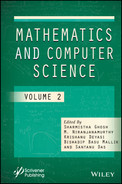MATHEMATICS AND COMPUTER SCIENCE This second volume in a new multi-volume set builds on the basic concepts and fundamentals laid out in the previous volume, presenting the reader with more advanced and cutting-edge topics being developed in this exciting field. This second volume in a new series from Wiley-Scrivener is the first of its kind to present scientific and technological innovations by leading academicians, eminent researchers, and experts around the world in the areas of mathematical sciences and computing. Building on what was presented in volume one, the chapters focus on more advanced topics in computer science, mathematics, and where the two intersect to create value for end users through practical applications. The chapters herein cover scientific advancements across a diversified spectrum that includes differential as well as integral equations with applications, computational fluid dynamics, nanofluids, network theory and optimization, control theory, machine learning and artificial intelligence, big data analytics, Internet of Things, cryptography, fuzzy automata, statistics, and many more. Readers of this book will get access to diverse ideas and innovations in the field of computing together with its growing interactions in various fields of mathematics. Whether for the engineer, scientist, student, academic, or other industry professional, this is a must-have for any library.
Table of Contents
- Cover
- Series Page
- Title Page
- Copyright Page
- Preface
- 1 A Comprehensive Review on Text Classification and Text Mining Techniques Using Spam Dataset Detection
- 2 Study of Lidar Signals of the Atmospheric Boundary Layer Using Statistical Technique
- 3 Optimal Personalized Therapies in Colon Cancer Induced Immune Response using a Fokker-Planck Framework
- 4 Detection and Classification of Leaf Blast Disease using Decision Tree Algorithm in Rice Crop
- 5 Novel Hybrid Optimal Deep Network and Optimization Approach for Human Face Emotion Recognition
- 6 An Application of Information Technology in Adaptive Leadership of Ministry of Ayush During Pandemic of Covid 19: A Case Study
- 7 Encoder-Decoder Models for Protein Secondary Structure Prediction
- 8 Hesitancy, Awareness, and Vaccination: A Computational Analysis on Complex Networks
- 9 Propagation of Seismic Waves in Porous Thermoelastic Semi-Infinite Space with Impedance Boundary Conditions
- 10 IoT Based Ensemble Predictive Techniques to Determine the Student Observing Analysis through E-Learning
- 11 Modelling and Analysis of a Congestion Dependent Queue with Bernoulli Scheduled Vacation Interruption and Client Impatience
- 12 Resource Allocation Determines Alternate Cell Fate in Bistable Genetic Switch
- 13 A Hybrid Approach to Ontology Evaluation
- 14 Smart Health Care Waste Segregation and Safe Disposal
- 15 Investigation of Viscoelastic Magnetohydrodynamics (MHD) Flow Over an Expanded Lamina Surrounded in a Permeable Media
- 16 Quickest Multi-Commodity Contraflow with Non-Symmetric Traversal Times
- 17 A Mathematical Representation for Deteriorating Goods with a Trapezoidal-Type Demand, Shortages and Time Dependent Holding Cost
- 18 An Amended Moth Flame Optimization Algorithm Based on Fibonacci Search Approach for Solving Engineering Design Problems
- 19 Image Segmentation of Neuronal Cell with Ensemble Unet Architecture
- 20 Automorphisms of Some Non-Abelian p−Groups of Order p4
- 21 Viscoelastic Equation of p-Laplacian Hyperbolic Type with Logarithmic Source Term
- 22 Flow Dynamics in Continuous-Time with Average Arc Capacities 327
- 23 Analysis of a Multiserver System of Queue-Dependent Channel Using Genetic Algorithm
- 24 An Approach to Ranking of Single Valued Neutrosophic Fuzzy Numbers Based on (α, β, γ) Cut Sets
- 25 Performance Analysis of Database Models Based on Fuzzy and Vague Sets for Uncertain Query Processing
- 26 Estimating Error of Signals by Product Means (C, 2) of the Fourier Series in a W(Lr, ξ (t))(r ≥ 1) Class
- About the Editors
- Index
- Also of Interest
- End User License Agreement
